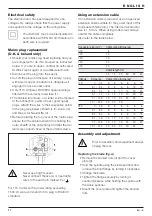
18
en - 5
E N G L I S H
Adjusting the depth of cut (fig. B)
The correct depth of cut for biscuit jointing is
determined by the size of the biscuit dowel:
Biscuit dowel size
Depth of cut
0
8 mm
10
10 mm
20
12 mm
• To set the correct depth of cut, turn the adjuster (2)
as required. The depth of cut can be read from the
scale.
Adjusting the blade to the panel thickness (fig. C)
The fine adjuster (5) allows centring the grooving
blade in the panel edge.
• Slacken the locking knob (14).
• Adjust the fine adjuster (5) as required.
The setting can be read from the scale (13).
• Tighten the locking knob.
Mounting and adjusting the parallel fence (fig. A)
• Slacken the locking bolts (12).
• Insert the rods of the parallel fence into the
corresponding holes in the base of the tool.
• Set the parallel fence to the desired position.
• Tighten the locking bolts.
Mounting the mitre fence (fig. A)
• Slacken the locking bolts (12).
• Fully insert the rods of the mitre fence into the
corresponding holes in the base of the tool.
• Tighten the locking bolts.
Mounting the cutting insert (fig. A & D)
• Remove the knurled nuts (4) and the cover plate (3).
• Carefully place the insert (16) in the recesses (15).
• Mount the cover plate and tighten the knurled nuts.
Dust extraction (fig. K)
• Insert the bolts (17) into the holes (18) in the dust
extraction adapter from the inside and
temporarily tighten the wing nuts (19).
• Slide the adapter onto the dust extraction outlet.
• Tighten the wing nuts.
• Connect the dust extractor to the adapter.
• Whenever possible, connect a dust extraction
device designed in accordance with the relevant
regulations regarding dust emission.
Instructions for use
• Always observe the safety instructions
and applicable regulations.
Switching ON and OFF (fig. A)
• To run the tool, press the ON/OFF-switch (1).
• To stop the tool, release the switch.
Do not switch the tool ON or OFF when
the blade touches the workpiece or other
materials.
Grooving
Cutting grooves for biscuit dowels (fig. E)
• Adjust the cutting depth as described above.
• Ensure that the star knob (6) is tightly fastened.
• Guide the tool parallel to the workpiece.
Grooving veneered and exotic wood panels
When grooving veneered and exotic wood panels,
use of the cutting insert is recommended to prevent
splintering (fig. D).
• Mount the cutting insert as described above.
• Set the required cutting width.
• Press the tool to a piece of soft wood and
carefully plunge the blade down through the
insert to produce a suitable slot in the insert.
Using the parallel fence (fig. G)
The parallel fence is used to groove parallel to the
edge of the workpiece.
• Mount the parallel fence as described above.
• Set the parallel fence to the correct distance.
Using the end marks (fig. A)
The end marks (11) are especially useful when
working on narrow workpieces and edges. The tool
is positioned by aligning the mark (11) with the edge
of the workpiece.
Scribing
Parallel scribing (fig. H)
The DW685K is ideal for parallel scribing on wall and
ceiling panels.
Summary of Contents for DW685K
Page 1: ...77 DW685K ...
Page 2: ...78 17 18 19 H K J 1 2 ...
Page 3: ...81 1 3 11 12 8 12 11 9 10 A1 ...
Page 4: ...82 1 3 8 4 2 7 4 6 5 2 B A2 C 13 14 5 ...
Page 5: ...83 11 D F G E 15 16 15 6 ...
















































